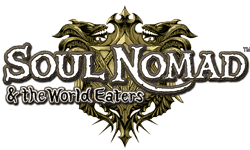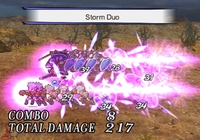|
|

|
PLATFORM
|
PS2
|
BATTLE SYSTEM
|

|
INTERACTION
|

|
ORIGINALITY
|

|
STORY
|

|
MUSIC & SOUND
|

|
VISUALS
|

|
CHALLENGE
|
Easy
|
COMPLETION TIME
|
40-60 Hours
|
|
OVERALL

|
+ Unique story premise is entertaining.
+ Multiple endings with a branching path.
+ Charming 2D character design.
- Too little tactical control in battle.
- Squad based play is implemented disappointingly.
- Awkward interface for constructing squads.
|
Click here for scoring definitions
|
|
|
A wise person at Nippon Ichi Software once thought, "Overlord Zetta was a great character in Makai Kingdom. What if we took him out of the Disgaea-verse and wedged him into a typical RPG story about amnesiac, ignorant fools trying to save the world? It would be like a badass Mystery Science Theater 3000!" And so the concept behind Soul Nomad and the World Eaters was born. 200 years ago, Gig, Angel of Death, ordered three monstrous World Eaters to annihilate the land. His crusade was halted with his body slain and soul sealed, and the World Eaters stood still. The game opens with the hapless hero-to-be fusing Gig's soul to his own. Gig spends the game trapped in his body, making wisecracks and not quite family friendly observations while the hero tries to save his dying world.
NIS tends to heavily tweak the turn-based strategy RPG formula for games outside of the Disgaea series, and Soul Nomad is no exception. Battles take place on a large grid with the lone hero facing a board full of hostile enemies. Fortunately, before losing his war 200 years ago, Gig learned an ability called dominion. Once the hero convinces someone to join his cause through means fair or foul, he or she will be dominated. Dominated characters are arranged in squads and can be summoned at any time by the hero. Each squad has a leader. On the battle grid, only the leader is visible and represents the entire squad.
When one leader attacks another, something wholly different from other strategy games occurs: the screen switches to a side view of the two teams duking it out. All members of the attacking group take a simultaneous turn first, then all surviving characters on the other side counter-attack. Once this is done the perspective reverts back to the overhead viewpoint. If a squad's leader dies in battle, his entire group is removed from the battlefield.
A group's leader also determines how the unit behaves on the battlefield. Turn order depends upon his ACT statistic, so a fast leader like a bandit will move sooner and possibly receive more turns per round than a slow leader like a mage. Leaders gain stats based upon a percentage of their minions' abilities and hence will be the strongest unit in each group. Each leader has unique abilities for battlefield use called "tactics". These resemble magic spells and their effects range from stat manipulation to damaging enemy units to placing traps on the battle grid.
 Combine certain unit types to enable combo attacks
Combine certain unit types to enable combo attacks
|
|
Selecting which unit classes and story characters to make leaders is largely the beginning and the end of any semblance of strategy in Soul Nomad. Nearly every other aspect of the game is handled randomly. To create a squad, Gig generates rooms with a 3x3 grid upon which the puppets of dominated characters are placed. How many of the nine potential slots are available for use, as well as where the slots are positioned on the grid, is determined by the luck of the draw.
The selection of the room type is also random. At first only a few different rooms are available. By the end of the game there are dozens of different rooms, each with a unique décor affecting it. Army creation consists of randomly generating a bunch of rooms, checking to see how many slots they hold and their décor, and then regenerating the rooms again if they are not up to par. Changing rooms in this fashion is an all or none decision. A particularly stellar room can be locked so it is not lost during the next room change, but the player is granted only enough locks to keep around half of the rooms in place.
To use a room, the hero places his underlings on the available slots in the 3x3 grid. Characters have different attacks depending upon which row they occupy. For example, a cleric in the back row heals everyone, a cleric in the middle row heals one person, and a cleric in the front row bops an enemy on the head with a thick book. The manual claims that row position also determines which enemy row will be attacked, but this is a lie. Melee attackers in the front row will always attack the opposing squad's front row. Other than that, minions in battle will target whoever they please.
This undermines the categorization of Soul Nomad as a strategy game. In a six on six skirmish, the attackers may be capable of destroying all the opponents in one attack; however they could all choose to attack the same enemy instead, thereby crushing one enemy in the squad instead of killing six. Which outcome occurs is up to chaos, not player choice. In one battle the archers may all attack the back row. The next turn, they may attack the middle row, leaving alive the wounded baddies from before instead of finishing them off. The vague commands Ogre Battle provided the player are deeply missed here. Often when it is tactically best to quickly slay an enemy leader, the attackers will leave him unharmed. Other times a squad will harmlessly scratch at the leader when they should instead be picking off puny support characters.
 You can beat up NPCs. Take that, Skinny Old Lady!
You can beat up NPCs. Take that, Skinny Old Lady!
|
|
The solution here, as is often the case in NIS games, is to power-level and leave the pathetic road blocks on the story maps in the dust. Who the team members target in battle is inconsequential when they are at twice the enemy level. Room inspections are the means to this end. The hero can inspect a room to fight battles on randomly generated maps. Winning these battles upgrades the room, raises character level, and grants room points for leader upgrades. These benefits together give the army a drastic boost and make the story battles a breeze. If this advantage is still not enough, new generic characters can be recruited at the same level as the hero, so stopping to level up newcomers is a thing of the past.
One manages the troops and rearranges squads through a horridly awkward menu interface. Whoever designed it throws away years of menu advancements to the extent that he could be accused of never having played a console RPG before. The battle interface is fine with some handy shortcuts. The generally unremarkable graphics are standard 2D fare, except during combat when the background is strangely 3D. It looks nice, but is a bit out of place in an otherwise 2D game. Units on the battlefield are clear and discernable to the point that the camera rarely requires tweaking: a potential first for a turn-based strategy RPG. Some of the bosses, particularly the World Eaters, have enormous sprites and look very impressive. Generic characters have a cute design aesthetic that borders more on the adorable side for humanoids than in past NIS games. As usual, the manual should be referenced to determine which generics are male and which are female due to their androgynous physical traits.
The one trick pony of a plot is consistently entertaining with some minor hitches. The hero, whose gender and name the player chooses, is tasked with destroying the three World Eaters left over from the war with Gig. The bland story touches upon every overused JRPG cliché in the book with one major twist: the foul-mouthed, sardonic Gig rides along in the lead's body, insulting and cursing at every mysterious, addle-minded, goody-two-shoes, "insert your least favorite cliché here" character in the plot. There is an obvious juxtaposition between Gig's carefree desire to watch the hero fail and everyone else's heart wrenching ordeals as their lives and world are torn asunder. Due to the player's choice of gender, the script gets awkward when someone speaks directly to the hero. Other characters use genderless nicknames for him/her and when the hero talks, his/her speech is unvoiced. Had the developers predetermined the lead's gender, these distractions would not be present.
All other story characters are voiced with expected NIS skill, although with less flair than usual. Only Gig inherits the maniacal tendencies typically spread across several characters in NIS games. Aside from a villainous cult full of lunatics, everyone else has a reasonable, if not intelligent, way of acting and speaking. In fights, generic units emit high-pitched, ungendered battle screams which are just acceptable enough not to be grating on the ears. The background music was scored by Tenpei Sato and is below average. Major battles have great music, but the score played during 90% of gameplay is featureless and unnoticeable.
When gauged solely as a potentially enjoyable RPG, Soul Nomad provides a decent romp through JRPG land, but to call it a strategy game is to insult the genre. A weak attempt at employing a sort of rock-paper-scissors system between character classes, the broken economy with an overabundance of cash, the suicidal, overly aggressive enemy AI, and the ease of power-leveling combine with a reliance on randomness where other games place tactical choices to create a gameplay experience where the player has little strategic say in the outcome. The game nearly plays itself at times. A unique slant on the plot and an odd attempt at squad based battles make the game different, but they were not particularly well implemented. Anyone looking for a strategy game should look elsewhere. If the concept of a strategy-lite game featuring a party member who mocks and swears at conventional RPG plot gimmicks is appealing, buy it up.
Review Archives
|









